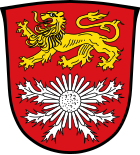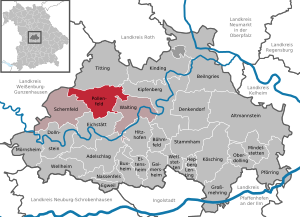Pollen field
| coat of arms | Germany map | |
|---|---|---|

|
Coordinates: 48 ° 57 ' N , 11 ° 13' E |
|
| Basic data | ||
| State : | Bavaria | |
| Administrative region : | Upper Bavaria | |
| County : | Eichstatt | |
| Management Community : | Eichstatt | |
| Height : | 534 m above sea level NHN | |
| Area : | 45.65 km 2 | |
| Residents: | 2984 (Dec. 31, 2019) | |
| Population density : | 65 inhabitants per km 2 | |
| Postal code : | 85131 | |
| Area code : | 08421 | |
| License plate : | EGG | |
| Community key : | 09 1 76 155 | |
| Community structure: | 10 parish parts | |
| Association administration address: | VG Eichstätt Gundekarstr. 7a 85072 Eichstätt |
|
| Website : | ||
| Mayor : | Wolfgang Wechsler ( FWG ) | |
| Location of the municipality of Pollenfeld in the Eichstätt district | ||
Pollenfeld is a municipality in the Upper Bavarian district of Eichstätt and, together with the municipalities of Schernfeld and Walting, forms the Eichstätt administrative community .
geography
Pollenfeld is located in the Franconian Jura , eight kilometers north of the district town of Eichstätt in the Ingolstadt planning region .
Neighboring communities
The neighboring communities are:
|
Raitenbuch ( Weißenburg-Gunzenhausen district ) |
Titting | Kipfenberg |
| Schernfeld |

|
Walting |
| Eichstatt |
Community structure
The municipality has 10 officially named parts of the municipality (the type of settlement is given in brackets ):
|
|
history
Until the church is planted
According to a legend, a man by the name of Pollo found the relics of St. Pope Sixtus II and other sanctuaries from Rome brought to this place, making the settlement a destination for pilgrims. The name Pollenfeld can be traced back to this man.
In 1250, Pollenfeld was the seat of a noble family and the seat of a clergyman who also took care of the surrounding towns.
Around 1420 the church was expanded in the Gothic style and 100 years later (1520) the high altar (in the altar shrine with Sixtus, Laurentius, Willibald and Walburga, Maria with the child) was consecrated.
In 1552, Pollenfeld lost its importance as a place of pilgrimage after relics were stolen.
The Pollenfeld church has always been incorporated into the Eichstätter cathedral chapter. The office of the Hochstift Eichstätt was from 1500 in the Franconian Empire and fell with most of the Hochstift area in the Reichsdeputationshauptschluss in 1803 to the Principality of Eichstätt of Archduke Ferdinand of Tuscany . Since the peace treaties of Brno and Pressburg in 1805, the place has belonged to Bavaria . In 1818, the municipality of Pollenfeld was created by the Bavarian municipal edict.
From 1912 pollen field was supplied with running water and electrified in 1920. In 1959 the school house was inaugurated. In 1966 the pollen field was channeled. In 1975 and 1976 extensive construction projects took place, in the course of which a gymnasium and outdoor sports facility were created. The local roads and sidewalks were also expanded. In 1978 the new parsonage and parsonage were inaugurated.
Incorporations
As part of the regional reform , the municipalities of Seuversholz, Sornhüll, Wachenzell, Weigersdorf (all on January 1, 1972) and parts of Preith (on May 1, 1978) were incorporated.
Population development
Between 1988 and 2018 the municipality grew from 2,409 to 2,916 by 507 inhabitants or 21.1%.
- 1961: 1921 inhabitants
- 1970: 1984 inhabitants
- 1987: 2378 inhabitants
- 1991: 2558 inhabitants
- 1995: 2782 inhabitants
- 2000: 2768 inhabitants
- 2005: 2808 inhabitants
- 2010: 2813 inhabitants
- 2015: 2836 inhabitants
politics
Municipal council
The municipal council of Pollenfeld has 14 members:
(As of local elections 2020 )
mayor
Wolfgang Wechsler from the Free Voting Association has been the mayor since May 1, 2014.
coat of arms
The coat of arms was designed by the heraldist Theodor Goerge from Freising and approved on December 6, 1985 by the government of Upper Bavaria.
Blazon : "In red over a silver thistle with six basal leaves a striding golden lion."
The municipality of Pollenfeld, which essentially consists of the places Pollenfeld, Preith, Seuversholz, Sornhüll, Wachenzell and Weigersdorf, was closely connected with the Eichstätter cathedral chapter. In the village of Pollenfeld the church had been incorporated into the Eichstätter cathedral chapter since time immemorial; the Popes Alexander III. or Urban III. confirmed ownership and rights to the cathedral chapter in 1179 in Wachenzell church and Meierhof and in 1186 in Sornhüll and Weigersdorf; in Preith the patronage, tithe and village court went to the cathedral chapter in 1302, in Seuversholz the cathedral chapter owned property until 1484. Because of these diverse relationships, the lion from the cathedral capital's coat of arms was adopted in the municipal coat of arms. The silver thistle , a typical plant of the Altmühljura, is a reminder of the municipality's location on the Jura plateau . Their six basic leaves symbolize the six parts of the community.
Attractions
- Gothic parish church of St. Sixtus in Pollenfeld
- St. Mary's Chapel in Seuversholz
- medieval fortified church in Preith
- prehistoric burial mounds in Sornhüll
- Filial church St. Martin in Wörmersdorf
Architectural monuments
Economy and Infrastructure
The Bosch Automotive Service Solutions GmbH has a production site in the community town of Preith.
Municipal tax receipts
The municipal tax revenue in 1999 amounted to the equivalent of € 1,068 thousand, of which the equivalent of € 283 thousand (net) was trade tax income.
Economy including agriculture and forestry
In 1998, according to official statistics, there were no employees at the place of work subject to social insurance contributions in the manufacturing industry or in trade and transport. In other economic areas, 47 people were employed at the place of work subject to social security contributions. There were a total of 1049 employees at the place of residence subject to social security contributions. There were nine companies in the manufacturing sector and eleven in the construction sector. In addition, in 1999 there were 114 farms with an agriculturally used area of 1950 ha, of which 1645 ha were arable land and 304 ha were permanent green space.
education
In 1999 the following institutions existed:
- Kindergartens: 100 kindergarten places with 101 children
- Elementary schools: one with 14 teachers and 197 students
Personalities
Sons and daughters of Pollenfeld
- Alois Brems (1906–1987), former bishop of Eichstätt.
- Franz Xaver Weigl (1878–1952), German educator.
Associated with pollen field
- Franz Xaver Bovius (1677–1725), German Catholic priest and manufacturer of sundials. Pastor in Preith from 1723 to 1725.
- Markus Buchheit (* 1983), German politician of the Alternative for Germany (AfD). Grew up in the Preith district from 1988.
- Antonellus Elsässer OFM (1930–2014), German Catholic theologian. From 1982 to 2010 parish administrator in Preith.
- Raymund Schlecht (1811-1891), German clergyman, teacher and music researcher. From 1834 to 1836 local chaplain of the pastor of Pollenfeld.
Web links
- Entry on the coat of arms of Pollenfeld in the database of the House of Bavarian History
Individual evidence
- ↑ "Data 2" sheet, Statistical Report A1200C 202041 Population of the municipalities, districts and administrative districts 1st quarter 2020 (population based on the 2011 census) ( help ).
- ^ VG in a new building. Eichstätter Kurier , November 16, 2016, accessed on January 2, 2017 .
- ^ Community of Pollenfeld in the local database of the Bavarian State Library Online . Bavarian State Library, accessed on September 14, 2019.
- ^ Wilhelm Volkert (ed.): Handbook of Bavarian offices, communities and courts 1799–1980 . CH Beck, Munich 1983, ISBN 3-406-09669-7 , p. 456 .
- ^ Federal Statistical Office (ed.): Historical municipality directory for the Federal Republic of Germany. Name, border and key number changes in municipalities, counties and administrative districts from May 27, 1970 to December 31, 1982 . W. Kohlhammer, Stuttgart / Mainz 1983, ISBN 3-17-003263-1 , p. 599 .




